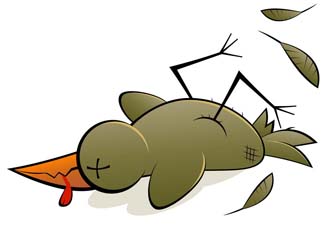
Photo courtesy of BigStock
It’s not uncommon for a veterinarian to hear, “He was fine until yesterday," even from devoted animal owners, when confronted with a pet wiping their feet on Death’s doormat.
Billy goat lies in the corner, round-bellied as the moon.
Pussy hides in the bushes, watchful as the noon.
Both leap to their feet when Master comes in and dash past the dog at the door.
Poor Fido, he gazes with a soulful eye and deposits his food on the floor.
--- Not-so-traditional nursery rhyme, author unfortunately known
It’s probably a sign of a misspent youth, but whenever I discuss animal behaviors, I picture the animals as illustrations from Richard Scarry books – particularly in nursery rhyme form. Goats wear overalls, dogs sport a variety of hats and raincoats, and cats often don aprons and mobcaps.
But animals aren’t furry people and they don’t respond to disease or pain the way humans do, or even in the same ways as each other.
I’ve been dealing with a sore throat for the past week. I’ve loudly (via text, because it hurts to talk) complained to anyone within electronic reach that it feels as though someone jammed a porcupine against my tonsils. Those who love me – or at least tolerate me – have been bombarded with daily updates on my plague-ridden status. While humans may vary in our whininess, as a species, we don’t tend to hide our maladies. We gripe on Facebook; we take sick days; we moan to our spouses, children, coworkers, and pets.
Despite the preponderance of pets on social media, very few of them post their own updates. With the reticence of Harper Lee, they hide their daily concerns from the public eye – and sometimes from the eyes of their owners.
Dogs are often more blatant than their feathered, feline, or hooved buddies. They puke on your shoes, drool and moan with a belly ache, thump sad tails when you jingle the leash. You dash to the phone to call the vet.
Dogs evolved from decent sized predators, so they have a little more food-chain security than many of our other domestic animals. If your job in the wild is to be eaten, you don’t really want to look like the one who would be easy to catch.
According to Dr. Ned Gentz, zoo veterinarian and consultant for the Veterinary Information Network (the parent of VetzInsight), “Sick prey animals fall prey to predators more easily than fit, well animals. So prey animals tend to mask being sick so that all the predators out there don't realize that they are sick.”
Cats are predators, yes, but they are likely to be chewed upon by those with larger teeth and claws if they aren’t wary. With the exception of raptors, most birds are nature’s version of flying Buffalo wings, tasty and conveniently packaged. And except for pigs, which are terrifyingly omnivorous, animals with hooves rank higher on the food chain than grass.
For these animals, retiring to their beds in grand Victorian manner for every belly ache or sore ankle would not be a sound survival strategy.
This means that these patients have a bad tendency to hide or be subtle about their disease signs until they are spiraling into the vortex of doom.
The cat that was “fine until yesterday” may have been sending subtle “Hey, I’m not feeling so good, but could ya not tell anyone?” signals for a week or two. My VetzInsight colleague, small animal practitioner Dr. Wendy Wilson, says “Cats that are hiding symptoms often hide themselves. Their habits change; they eat differently, drink differently, groom less often or are unkempt. They don't jump up on stuff like they used to, they sleep in different places, and they don't interact as much.”
The goat suddenly appearing flat out in the pasture with its eyes rolling back in its head probably wasn’t normal yesterday, but he might have failed to mention it. It can be difficult to monitor things like eating, drinking, and urine output for individual animals in a herd, so learning to look at individual animals for sunken flanks, changes in coat, changes in activity or posture is a good idea.
Dr. Gentz points out that birds often like to present as the parrot from the Monty Python sketch. “Many veterinarians are reticent about seeing and treating sick birds because these patients have a reputation for dying in your hand. It can happen. It has happened to me and it can happen to you.”
However, he notes that there are some clues to a pre-dead parrot or budgie. “Sick birds can be very subtle. Singing birds sing less. Talking birds talk less. They close their eyes a little more. They fluff up their feathers. Sitting on the bottom of the cage -- now that's a seriously sick bird.”
Watching your bird, or any pet, for such subtle signs can help them survive whatever malady they are hiding from you and predators. Doing so will help ensure that your cow will be ready for her next lunar orbit.